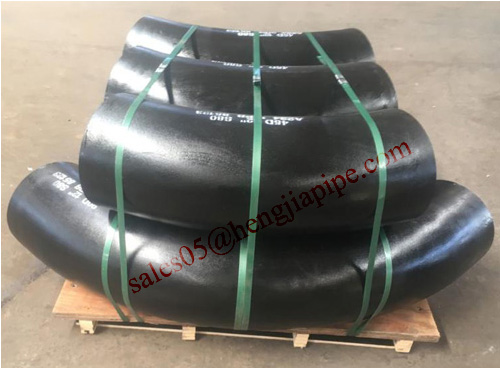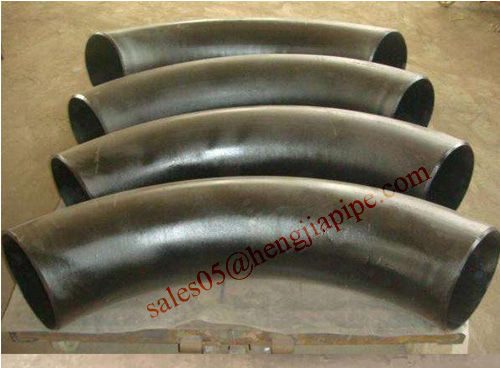The State Council approved Beijing's heavy-duty diesel vehicles from June 1, 2015 to fully implement the "Combustion Compression Ignition, Gas Fuel Ignition Engine and Automotive Exhaust Pollutant Emission Limits and Measurement Methods (China Phase III, IV, V) (GB17691-2005) Standard fifth-stage emission control requirements, Beijing became the first city in the country to fully implement the national five-phase vehicle emission standards. It is estimated that after the implementation, the nitrogen oxides of bicycles in the fifth stage of heavy-duty diesel vehicles in Beijing can be reduced by about 40%.
Compared with elbows, bend will have tangent length if the customers need. The bend radius is larger than elbows`. When it is more than 2D, it is called bend. There are 3D, 5D, 7D, 10D bends. Below picture is 3D Bend with tangent length, angle is 45deg and 90deg.
Carbon steel 3D bend
These bends are packed by wooden pallet because of big volume.
As for manufacture standard, it is different from other pipe fittings. Its standard is ASME B16.49.
Materials are carbon, alloy and stainless steel. Wall thickness in common use is STD, XS and so on. With the development of the society, steel bends are widely applied in oil & gas transportation of pipeline system.
Steel Bend Pipe Bends,Weld Bend,3D Bend,Black Steel Bend CANGZHOU HENGJIA PIPELINE CO.,LTD , https://www.hj-pipeline.com
At present, the contribution of PM2.5 in the atmospheric environment of Beijing, motor vehicle emissions accounted for 31.1%, the largest proportion. Among them, the problem of emission pollution of heavy-duty diesel vehicles with a maximum total mass of more than 3.5 tons is particularly prominent.
According to the latest pollution source analysis results released by the Ministry of Environmental Protection, motor vehicle pollution is the primary source of air pollution in Beijing, Hangzhou, Guangzhou and Shenzhen. It is the second largest source of atmospheric pollution in Tianjin and Shanghai, and it has become one of the main factors affecting ambient air quality. . It can be seen that the pollution control of motor vehicles is imminent.
As a diesel vehicle with a large exhaust emission of motor vehicles, although the proportion is small, the contribution rate is high and the emissions are large. According to relevant data, the nitrogen oxides emitted by diesel vehicles, which account for 16.1% of the total number of motor vehicles in the country, are close to 70% of the total emissions, and the particulate matter exceeds 90% of the total emissions, and the massive emissions of heavy-duty diesel vehicles are responsible for this. The important reason for the result. Therefore, the management of diesel vehicles, especially heavy-duty diesel vehicles, is the focus of vehicle pollution control, and the improvement of such vehicle management systems is of paramount importance. After investigation, the author found that from the current situation, there are still many shortcomings in the management system of diesel vehicles (especially heavy-duty diesel vehicles), which are manifested in the following three aspects.
The incremental management system for diesel vehicles (especially heavy-duty diesel vehicles) is missing. To control the pollution of such vehicles, the first is to control the total amount and reduce the increment. Although many places in China have implemented measures such as incremental quota index management and motor vehicle limited purchase restriction, the traffic environment has been optimized to a certain extent and air quality has been improved. However, separate total control and indicator management has not been implemented for high-pollution, high-emission vehicles such as diesel vehicles, especially heavy-duty diesel vehicles. It is precisely because of the lack of effective total control mechanism and restrictions on purchase restrictions, coupled with the fact that some car owners have privately sold and disposed vehicles without transfer registration, resulting in an absolute number of such vehicles in the context of rapid socio-economic development and expanding market demand. The proportion of the proportion and the continuous growth will inevitably lead to high levels of particulate matter and nitrogen oxides in the atmosphere.
Transport companies lack management systems for diesel vehicles (especially heavy-duty diesel vehicles). Large enterprises such as ports, tourism and logistics are the major users of such vehicles, and they are highly dependent on the transport vehicles they carry. Due to the weak awareness of energy conservation and emission reduction in some enterprises, they pay attention to their own economic benefits and neglect their due environmental responsibility. In the management of such vehicles, there is a lack of strict and standardized systems that meet the requirements of environmental protection, and freely configure or lease long-age vehicles and aging vehicles. Diesel vehicles with backward emission technologies, especially heavy-duty diesel vehicles, cause large amounts of harmful gases to be emitted, causing serious harm to the ambient air.
The road traffic management system for such vehicles is missing. Some heavy-duty diesel vehicles can sometimes be free from regional restrictions and time-limited restrictions, and can easily travel through urban roads, which not only poses safety hazards, but also causes serious pollution. Especially in the case of large road traffic flow and road congestion, long-term heavy-load low-speed operation or idling operation, the pollutant emissions increased sharply, especially for local air quality.
Strengthening the control of diesel vehicles, especially heavy-duty diesel vehicles, plays an important role in improving ambient air quality. In view of the above-mentioned lack of system, the author suggests that we should focus on improving the management system from the following three aspects.
First, improve the total control system for diesel vehicles (especially heavy-duty diesel vehicles). Taking Tianjin as an example, the number of motor vehicles in the city has continued to climb in recent years, reaching 2.84 million at the end of 2014, and will increase by at least 100,000 vehicles per year. In order to meet the requirements of economic and social development and ecological civilization construction, the total amount of motor vehicles should be continuously regulated, including not only small passenger cars, but also diesel vehicles, especially heavy-duty diesel vehicles. It is recommended that the relevant departments further carry out research on the regulation and control of urban motor vehicle development, explore the introduction of a more stringent motor vehicle total regulation system, and incorporate diesel vehicles, especially heavy-duty diesel vehicles, into the total amount of regulation and management, and implement restrictions and purchase restrictions simultaneously with small passenger vehicles. . Through regulation and increment, the development speed and scale of diesel vehicles, especially heavy-duty diesel vehicles, can be effectively controlled to reduce the pollution caused by the excessive growth of such vehicles.
Second, improve the operational supervision system for diesel vehicles (especially heavy-duty diesel vehicles) of large transportation enterprises. Strengthen the environmental responsibility of such enterprises and vigorously develop green transportation through various measures and ways. It is recommended that relevant departments strengthen the operation and supervision of the above-mentioned vehicles of such enterprises, and clearly require enterprises to strictly select the use of green transportation tools, optimize the structure of transportation vehicles, and reduce the emission intensity of bicycles. On the one hand, enterprises should carry out regular self-inspection of their own vehicles, update and upgrade their over-time service vehicles, and select environmentally-friendly vehicles with stable performance and low exhaust emissions. On the other hand, it is necessary to use market-based means to encourage enterprises to include low-emission vehicles as rigid indicators in leasing contracts when leasing transportation vehicles. At the same time, establish an enterprise environmental protection credit assessment system, include the proportion of environmentally-friendly vehicles in the assessment, and form a long-term system based on practice.
Third, improve the road traffic management system for diesel vehicles (especially heavy-duty diesel vehicles). An important aspect of controlling the serious pollution of urban air emissions from such vehicles is to continuously improve the urban road traffic management system and scientifically and strictly restrict such vehicles on the road, thus effectively reducing the overall vehicle emissions. It is recommended that the relevant departments study and improve the control system for low-emission areas in the administrative area, delineate the scope of low-emission areas, and propose requirements for vehicles entering low-emission areas from the aspects of control time and control objects, thereby encouraging the use of clean vehicles and prohibiting diesel vehicles. Especially high-emission vehicles such as heavy-duty diesel vehicles. On the basis of sorting out the traffic flow of urban roads, congestion of road sections and the operation of such vehicles, the key control areas will be delineated according to the actual situation, and the hierarchical treatment will be carried out with the surrounding areas of 1 km, 3 km and 5 km as the core. Cars, especially heavy-duty diesel vehicles, are banned within a certain range, and the vehicle's driving route is reasonably planned to reduce the number of such vehicles passing through the city's main urban area, thereby reducing the impact on the regional ambient air quality.


· What are the current diesel vehicle management systems?
